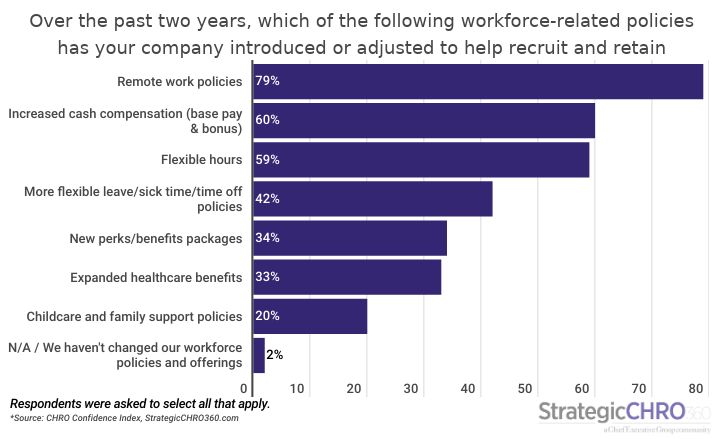It’s no secret that the state of work and the office has experienced a massive upheaval in recent years. Amid the impact of Covid-19, low unemployment and difficulty recruiting, businesses and CHROs, in particular, have needed to become more flexible and creative.
In our latest CHRO Talent Index poll, of 120 CHROs from November 14-17, we asked HR leaders what new work policies they’ve initiated in these challenging times—and what’s been successful. We also gained insights into trends such as “quiet quitting” (have you heard of it?) and turnover rates.
Some results were confirming: 79 percent of CHROs say their company has introduced remote work policies over the past two years—the most common new policy. Following that, 60 percent of CHROs say their company has increased cash compensation. And the third most popular new work policy? Flexible hours. It has been implemented by 59 percent of CHROs’ companies over the past two years.
In their comments, HR leaders also noted that employees want to feel part of something bigger. “One-on-one connection, and ensuring employees see a pathway for growth and greater contribution is more important now than ever. Employees are also bringing their values to the forefront as something that must be aligned and supported by the organization that employs them. Actions speak louder than words for the new generation of employees and they want to be a part of those actions,” said Petrina Gooch, principal, corporate HR leader at HED, a professional services firm.
How well these new policies appear to be working may be more surprising. Most CHROs reported that their policies have been only “somewhat successful”—or 3 out of 5, where 5 is “highly successful” and 1 is “not successful.” Childcare and family support policies, along with new perks/benefits packages received the highest proportion of responses as 4 or 5, at 63 percent. The lowest ranked policy was increased cash compensation, with only 44 percent of CHROs responding that it was a 4/5 or 5/5.
“Pay has become a driving factor and is a meme that has turned traditional pay practice on its head,” says the VP of HR at a large, not for profit healthcare payer/provider.
“We have loyal employees; however, we have had to make improvements to our total compensation packages to be able to attract the best talent. Since the onset of Covid, we have seen that employees want freer and more flexible time without an impact on earnings. It has made it challenging to say the least,” says AnaMaria Greenberg, director of human resources at CME Wire & Cable.
Employee Turnover
The war for talent is top of mind for CHROs in all industries. Our research shows that since the beginning of the year, more than a third, or 34 percent, of CHROs have seen an increase in their organization’s turnover rate. One third of CHROs said that their organization has experienced about the same level of turnover, and 32 percent have experienced less.
When examining change in turnover rate by industry, we see that one in five CHROs in industries like construction and wholesale/distribution said their organization has experienced significantly higher turnover than the beginning of the year. On the other side of the spectrum is CHROs in financial services and tech, where one in five HR leaders reported that their organization is experiencing significantly lower turnover now compared to the start of the year.
By company size, we see that half of CHROs in companies with at least $1 billion in annual revenues reported that their organization has experienced an increase in turnover, although none reported a significant increase. In large companies with revenues of $500 million to $999.9 million, half of CHROs reported a decrease in employee turnover since the beginning of the year—the highest proportion reporting a decrease across all sizes.
Quiet Quitting and Layoffs
Quiet quitting, of course, refers to remaining in an organization while doing the absolute minimum required of the role, putting in no extra time, energy or enthusiasm. We asked CHROs about the latest buzz phrase—and 47 percent say that they have observed a certain degree of evidence of the trend.
Thirty-eight percent of CHROs say that they have not observed quiet quitting. Another 10 percent say that it’s hard to tell, while 5 percent claim that it has been significant.
“This is a new name for an old problem, so we are not seeing any uptick,” says the VP of HR at a mid-size tech company, echoing many of his peers.
Another trend getting a lot of attention: tech company layoffs, including at such behemoths as Meta, Amazon and Twitter. While it may be a sign of what’s to come across industries, we saw indications it could be isolated to the tech sector. We asked CHROs their opinion on general layoffs in this economic downturn and 48 percent said that their company has been reluctant to lay off employees or reduce headcounts due to anticipated recruitment challenges post-recession. The other 52 percent said that their companies have not been reluctant.
About the CHRO Talent Index
The CHRO Talent Index is a pulse survey of U.S.-based CHROs and HR executives at organizations of all types and sizes on their perspective of the economy and how policies and current events are affecting their companies and strategies. Every quarter, StrategicCHRO360 asks participating CHROs about their top issues and challenges for the months ahead. The results are published on StrategicCHRO360.com and a report is distributed to participants.








